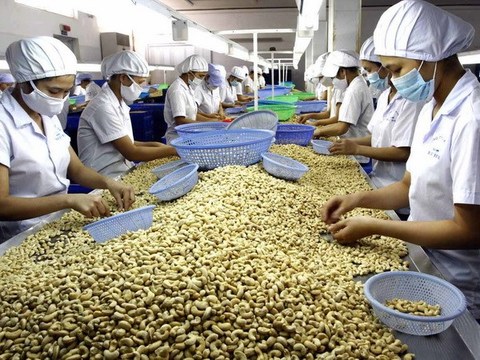Though the UK-Vietnam Free Trade Agreement (UKVFTA) is considered an opportunity for Vietnamese farm, forestry and fishery products to further enter the British market, Vietnamese exporters must better meet clean and green quality requirements of the EU’s second-largest economy to enable them to enlarge the market share amid rising competition, experts said.
According to the Ministry of Agriculture and Rural Development (MARD), Viet Nam's agricultural, forestry and fishery products have an advantage when exporting to the UK as 94 per cent of the total 547 tariff lines of agricultural products enjoy zero per cent tax incentives under the UKVFTA.
In fact, Viet Nam's farm, forestry and fishery exports to the UK have increased sharply thanks to the UKVFTA, with last year’s export value surging by 71 per cent compared to 2020. The UK is currently in the Top 5 seafood export markets and the Top 3 wood export markets of Viet Nam. Cashew nuts, coffee and rice are also traditional products that Viet Nam has strengths when exporting to the UK.
According to former British Ambassador to Viet Nam Gareth Ward, the UK has a free trade policy and a large demand for agricultural products. Trade cooperation between the UK and Viet Nam will go further because the structure of the import-export products of the two countries is complementary instead of competing with each other.
However, in the near future, the UK will deploy a series of FTAs with 19 countries and prepare to join the Comprehensive and Progressive Agreement for Trans-Pacific Partnership (CPTPP). When these agreements are signed, the UKVFTA advantages for Vietnamese enterprises will no longer exist. Therefore, Vietnamese exporters must make great efforts in production and increase access to the UK market.
Meanwhile, the UK is a very demanding market on traceability and product quality standards, especially food safety and hygiene. Therefore, Vietnamese exporters need to learn and grasp all information about the market, from consumer tastes to regulations and standards on rules of origin, food safety and hygiene.
British consumers prioritise and readily pay higher for organic products and goods that meet safety and hygiene standards with no residues of pesticides. Therefore, Vietnamese producers and exporters must develop clean and green production to meet the tastes and demands of British consumers.
Government support
The Government has so far implemented many policies to promote green agriculture with an aim to help Vietnamese products raise competitiveness in the global market in general and in the UK in particular.
MARD’s Deputy Minister Phung Duc Tien said at the 26th United Nations Climate Change Conference of the Parties (COP26), Vietnamese Prime Minister Pham Minh Chinh made a commitment that Viet Nam will strive to achieve net-zero carbon emissions by 2050.
At COP26, related to the agricultural and forestry sectors, Viet Nam also signed the Global Methane Pledge aimed at reducing methane emissions by 2030 and joined the Glasgow leaders’ declaration of forest and land use.
Deputy Prime Minister Le Van Thanh has recently also approved a project on tasks and solutions to implement the outcomes of the COP26. The project targets activities to reduce greenhouse gas emissions in several sectors, including agriculture. The project encourages circular, low-carbon agriculture; the protection, preservation and sustainable use and development of forests; and climate change response.

Workers process cashew nuts for exports at a company in the southern province of Binh Phuoc. Cashew is among traditional products that Viet Nam has strengths when exporting to the UK. — VNA/VNS Photo
Besides, according to Tien, under the National Green Growth Strategy for 2021-30 with a vision to 2050, the MARD has been assigned to develop an efficient, sustainable and low-carbon commercial agriculture toward a circular and smart economy, climate resilience, and higher competitiveness for green agro-products, build new green and sustainable rural areas with models of climate resilient ecological/smart villages.
MARD is also drafting the sustainable agriculture and rural development strategy for 2030 with a vision to 2050, aiming at agricultural restructuring, developing the rural economy, and linking with new rural development. The strategy is structured around three pillars, which are ecological agriculture, modern countryside and smart farmers, to completely support Viet Nam’s future national strategic orientations.
Nguyen Duc Truong, General Director of Dai Thanh Joint Stock Company, said to achieve the net-zero carbon emission goal by 2050, Viet Nam's agricultural sector needed to apply new methods and technologies in production, such as using organic and bio-fertilisers.
Besides, Truong said, the application of drones in agricultural production would also be a solution to help reduce greenhouse gas emissions.
Drones uses batteries, instead of fossil fuels such as gasoline and oil, thereby it will cut a large amount of greenhouse gas emissions. In rice production in Viet Nam, especially in large production areas such as the Mekong Delta, the application of drones will support farmers to fully automate the stages of sowing, spraying pesticides, spreading fertilisers, which will help cut at least 20 per cent of pesticides in production, according to Truong.
Kyle Kelhofer, International Finance Corporation’s Senior Country Manager of Viet Nam, Cambodia and Laos, said: “Viet Nam’s agriculture sector is at a turning point. The sector faces bright opportunities in both domestic and international markets, yet effectively competing in these will depend upon the ability of farmers and firms to deliver agricultural products with reliability, and with assurances relating to quality, safety, and sustainability.”
“Transformation to a low-carbon, green and sustainable growth path will be key to making this happen,” he said. — VNS